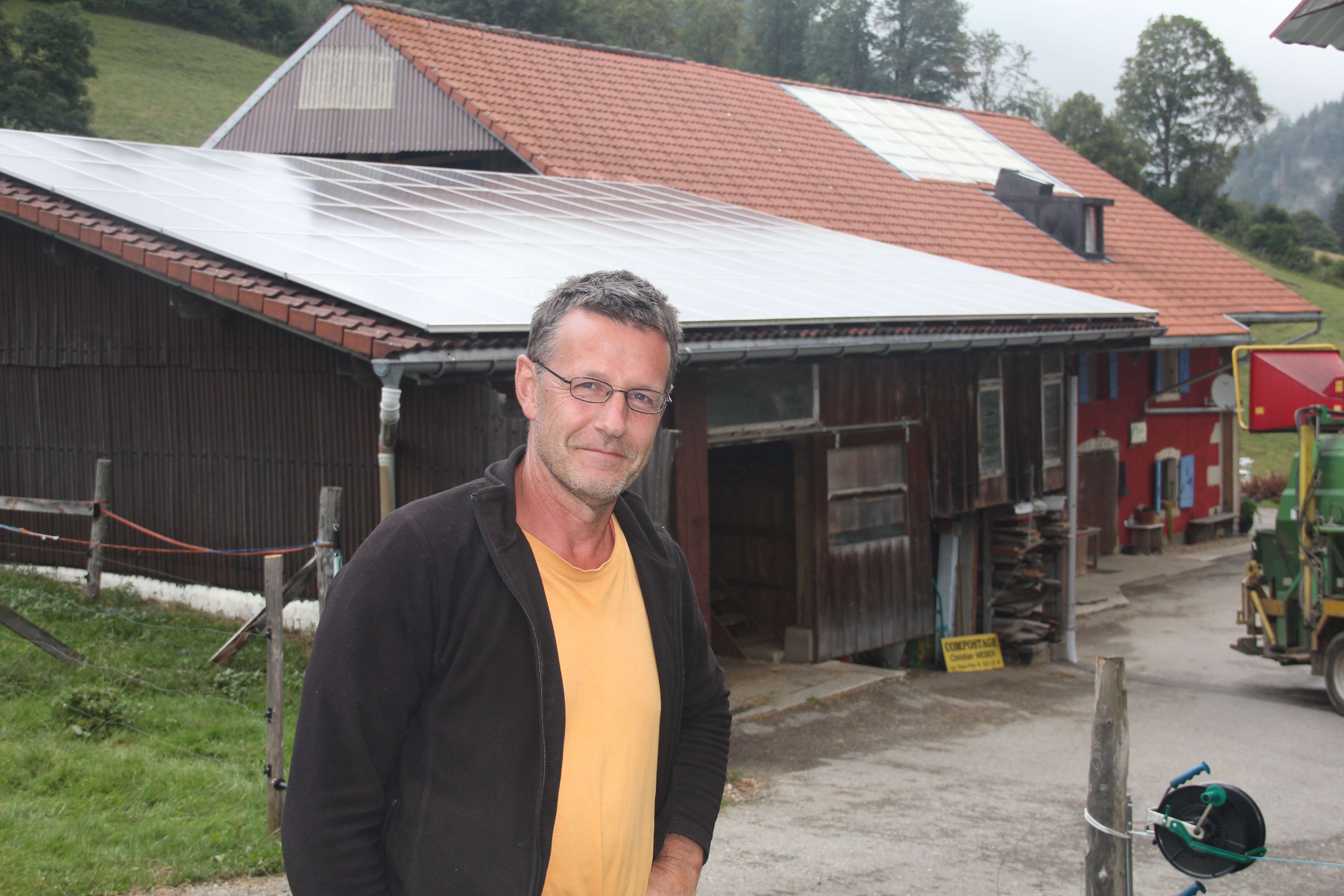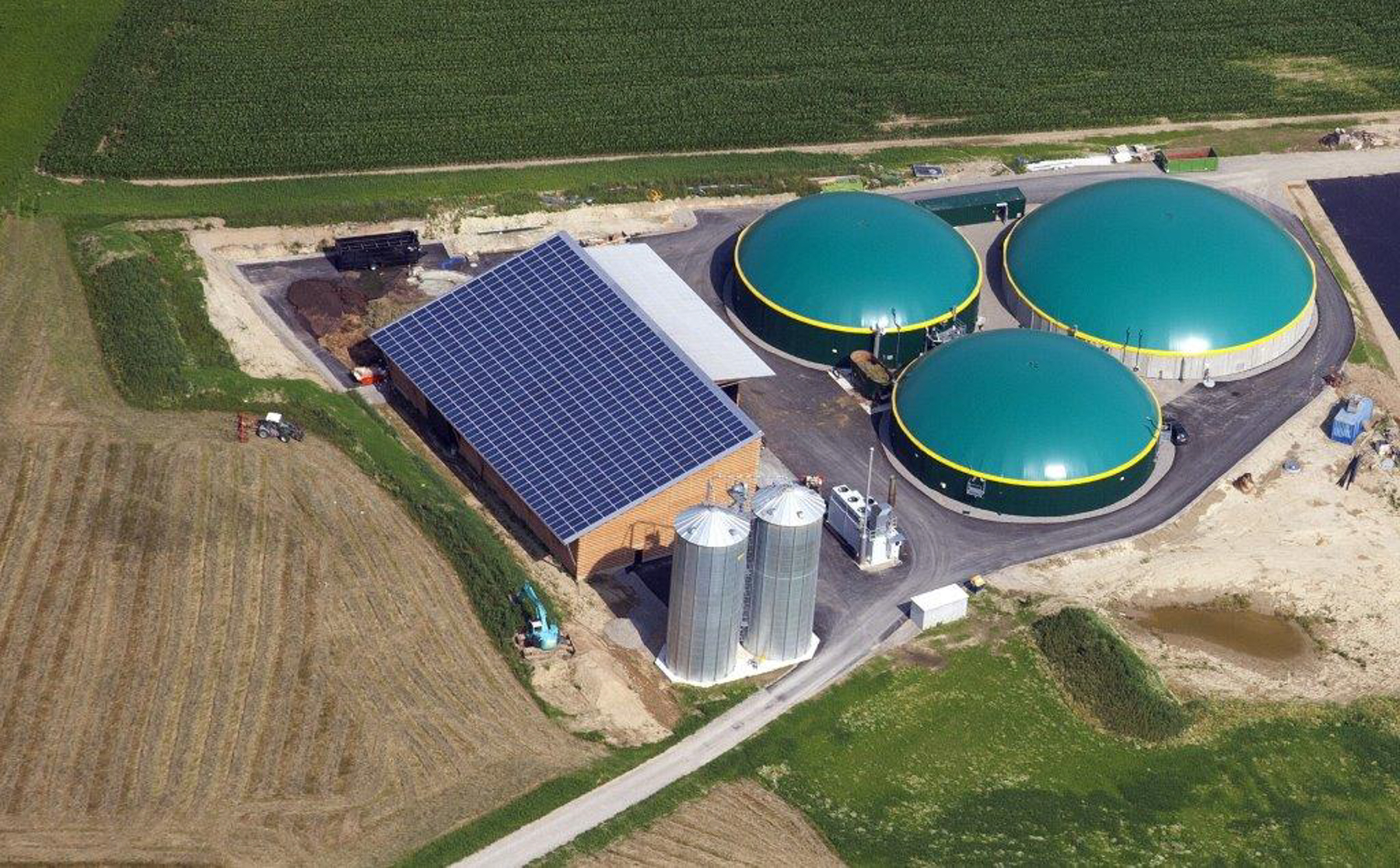Farmers look to grow their solar and wind power

Wide roofs available for solar panels, land for wind farms, biomass for generating biogas - Swiss farmers often have all the resources needed for renewable energy. For some, like Christian Weber, a healthy dose of idealism also helps.
The energy issue has become so important in recent times that we should all be concerned about it. We, as farmers, have everything required to produce clean energy on our own,” says Weber, a farmer in Val-de-Ruz, in canton Neuchâtel.
In this region of the Jura mountains, where there is often a metre of snow in winter and the farms are scattered among the forests of fir, beech and maple, farmers have always been self-sufficient energy-wise. Linked only to the electricity grid and phone lines, houses are traditionally heated with wood. Every farmer has his own well or cisterns to collect rainwater.
“We are proud to depend as little as possible on oil transported here from the Middle East or who knows where,” insists the farmer, who drives an electric car.

More
Turning biogas into electricity
Energy bug
Isolation makes these farming folk resourceful, a skill Weber has in abundance. After completing secondary school, he decided to follow in his grandparents’ footsteps – they were farmers in canton Bern. So he bought a farm in the Jura mountains where he could live in the middle of nature with his family. “I did not want to work the land in some urbanised region, maybe right beside a motorway,” he explains.
For some time now he has been doing organic farming, which can be quite a laborious task in a region above 1,000 metres’ altitude. More than twenty years ago he started a system for collecting biomass and compost for the communes of Val-de-Ruz, which in 1993 won him an innovation in agriculture prize from the Swiss Farmers’ Association. Then, a few years ago, he caught “the renewable energy bug,” as he calls it.
“My dream at the start was a small wind farm,” he says. “But then I realised that solar energy is much less costly and easier to implement.” So he covered the roofs of his farm buildings with photovoltaic panels and today he produces enough electric power for six households, which he resells under a 20-year contract to Zurich’s power company.
“This is virtual power supply – the electricity is consumed here in the region. But in a city like Zurich, where the environmental sensibilities tend to be greater, some customers are prepared to pay a bit more to support renewable energy.”
Since 2009 the Swiss government has been encouraging production of electricity from renewable sources with a programme of “cost-covering remuneration for feed-in to the electricity grid” (CRF).
This mechanism, funded by a tax on every kilowatt hour consumed, provides extra income for producers of “clean” electricity.
In practice it covers the difference between the cost of production and the market price of electricity for a period of 20-25 years.
At the end of 2012, about 5,000 facilities were being supported by the CRF programme. Around 30,000 already existing projects or facilities are still on the waiting list.
Following a parliamentary initiative, the CRF fund is to have extra funds from next year. An increase in the tax has been proposed from 0.9 to 1.5 centimes per kilowatt hour of electricity consumed.
A further increase, up to 2.3 centimes, is planned as part of the government’s Energy Strategy 2050.
Little Ferrari
After that first step, he decided to expand. Together with a friend he installed 1,600 square metres of photovoltaic panels at a riding school at Derrière-Pertuis, a few kilometres from his farm. “It’s taken off like a little Ferrari. We can meet the electricity needs of 60 households,” he says with enthusiasm.
The installation, inaugurated about a year ago, will be amortised but will only start to make a profit in about 20 years’ time. “For me, with no pension fund, it’s a bit like an old age pension,” explains Weber. “But it’s certainly no goldmine. An investor who wants a good return doesn’t invest in something like that. A banker would be more likely to buy shares in Apple.”
He had no chance anyway of getting a loan from a bank. To finance the operation he had to dip into his own savings and get help from family members. But what kept him going was passion and a definite sense of responsibility. “We farmers are the caretakers of the land in Switzerland. We have to look after it and use it to produce food energy. But now we can produce electric energy out of it too and I don’t see why we shouldn’t.”
Long waiting list
His vision is shared by the Swiss Farmers’ Association, which created the information and advice platform Agrocleantech in 2011 to promote renewable energy sources and energy efficiency among farmers.
“Food production has to remain the priority in Switzerland. Solar panels, for example, need to be installed on roofs and not on farmland,” notes Armin Hartlieb, director of Agrocleantech. “But we believe that agriculture has a lot of potential when it comes to energy. According to a study we did, by 2030 we should be able to produce 2,100 gigawatt hours (GWh) a year of electricity and 1,300 GWh a year of heat.” That’s as much as is generated in a year by the – soon to be decomissioned – Mühleberg nuclear power plant.
But Switzerland has exploited this potential very little compared with other countries like Germany, where there is much more government support for renewable energy. “Today there are about 30,000 projects on the waiting list for CRF (cost-covering remuneration for feed-in to the electricity grid) funding [see infobox],” explains Hartlieb.
“This money from the government covers the difference between the cost of production and the market price and is indispensable for ensuring profits at many facilities.”
Although the government and parliament are now in favour of increasing the programme’s budget, it will take many years to work through the waiting list.
New project
Among the power plants waiting for approval is Weber’s at Derrière-Pertuis. But the farmer is not just content to sit and wait. He has already started a new project to build a wind farm a few kilometres away at La Joux-du-Plâne: 12 large wind turbines which would supply electricity to more than 12,000 households.
The project, which has the support of some 20 local farmers, will be submitted to the government next year, but has already won canton Neuchâtel’s 2012 prize for farming innovation.
The farmers have already done feasibility studies, and they have measured and documented the wind, flight paths of migratory birds, and impact on bats. For funding – between CHF60 million- CHF80 million ($66 million – $88 million) – they have signed an agreement with the canton’s main power company. “But the project belongs to us,” Weber points out. “We have three seats out of five on the steering committee.”
The wind farm is to be built entirely on land belonging to the participating farmers, but the promoter foresees a long battle with environmental organisations, whom he expects to oppose it.
“I consider myself an ecologist, but at times I have trouble understanding the views of some environmentalists,” he says. “They seem more worried about bats than about radioactive waste or climate change.”
In Switzerland renewable energy sources cover a little more than 20% of total energy consumption. Most of this percentage comes from traditional energy sources: water (13.7%) and wood (4.2%).
The “new” renewable energy sources (sun, wind and biomass) provide only 2%.
As shown in other parts of Europe, in particular in Germany and in Scandinavian countries, the agricultural sector has great potential for developing renewable energy.
A study by Agrocleantech found that by 2030 farmers could produce 3,400 GWh a year of electricity and heat, or about 100 times more than at present.
The study sees development possibilities for solar energy and biogas in particular. By 2030 all farm buildings could be covered in solar panels and there could be 1,200 production facilities for biogas (at the moment there are only around 100).
(Translated from Italian by Terence MacNamee)

In compliance with the JTI standards
More: SWI swissinfo.ch certified by the Journalism Trust Initiative

You can find an overview of ongoing debates with our journalists here. Please join us!
If you want to start a conversation about a topic raised in this article or want to report factual errors, email us at english@swissinfo.ch.